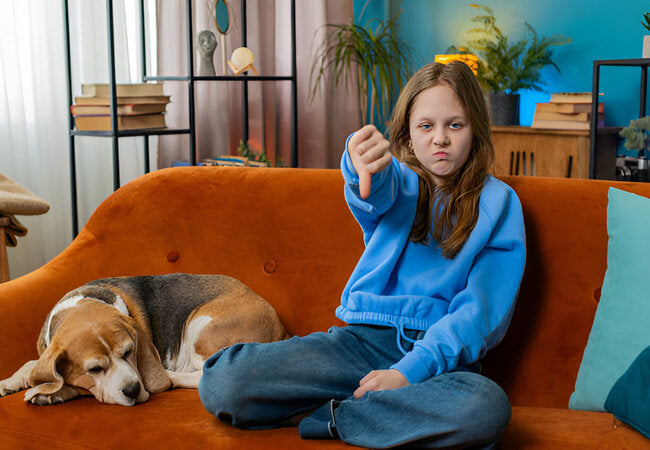You're Not a Bad Pet Parent If Your Dog Doesn’t Like Kids in 2025 – Vet‑Approved Insights & Compassionate Guidance 🐶👶

In this article
You’re Not a Bad Pet Parent If Your Dog Doesn’t Like Kids in 2025 – Vet‑Approved Insights & Compassionate Guidance 🐶👶
By Dr. Duncan Houston BVSc
As a pet parent, seeing your dog stiffen or bark when kids come close can be distressing. It’s easy to feel guilty, believing you’ve done something wrong. But in 2025, veterinarians understand that many dogs simply aren't comfortable around children for valid, understandable reasons. This vet‑approved guide explains why, and provides practical, compassionate strategies to keep them safe, help them grow more confident, and preserve a happy home. 🐾❤️
1. ❓Why Some Dogs Don’t Like Kids
A. Lack of early socialization
If your dog wasn’t gently introduced to children during the important socialization window (3–16 weeks), unfamiliar kid‑specific behaviors—rapid movements, loud voices—might feel threatening.
B. Past negative experiences
Even a single traumatic encounter—like being grabbed, stepped on, or chased—can create lasting fear. Dogs can associate kids with stress and act defensively.
C. Unpredictable behavior
Kids: high‑energy, loud, unpredictable. Many dogs, especially shy or anxious ones, simply don't cope well with that environment.
2. ⚠️ Signs of Kid‑Related Stress
Reactive behaviors can be subtle:
- Avoidance: walking away, hiding
- Subtle stress signals: lip licking, yawning, tense body posture
- Louder cues: barking, growling, snapping at approaching kids.
Recognizing early warning signs is essential—intervening before a child becomes scared or your dog feels trapped can prevent escalation.
3. ✅ Vet‑Approved Safety & Support Strategies
A. Respect and manage boundaries
- Use gates or crates to create kid‑free zones at home.
- Safeguard public outings—use leashes, “do‑not‑pet” gear, or block access gently.
- Body block—place yourself between the dog and the children when approached unexpectedly.
B. Teach children respectful interaction
- Invite kids to wait until the dog approaches, sit calmly, and let the dog sniff their hand.
- Teach “soft touches” and no grabbing—especially avoid hugging or sudden movements.
- Explain “no” signals like backing off or calming down when the dog looks worried.
C. Counter‑condition & desensitize
- Start at a distance where your dog remains calm near kids—treat for relaxed behavior.
- Gradually decrease the gap, continuing rewards for calmness.
- Celebrate small wins—ignoring a child passing by matters!
D. Use enriching alternatives
- Provide chew toys, food puzzles, or safe spaces before visits—these work as distractions and comfort.
- Offer anxiety tools like calming music, pheromone diffusers, or Thundershirt during exposure periods.
E. Seek professional help when needed
- A certified, force‑free trainer, or veterinary behaviorist can design trauma-informed plans.
- In more anxious dogs, medication or supplements may be needed alongside training.
4. 💬 Reddit Owners’ Insights
> “We try and keep her away from children she doesn’t know… she just doesn’t like the rough handling.”
> “I always tell random people they’re not friendly… picking her up before they get too close.”
These stories highlight thoughtful management—creatively using vests, harnesses, and verbal cues to protect dogs and educate people.
5. 🌱 Progress Takes Time—And That's Okay
Changing fear-based behavior isn't instant. It takes consistent, patient steps—sometimes months or years. But even small improvements in confidence and calmness are meaningful
Signs of Progress:
- The dog looks at children without appearing tense.
- Begins to eat treats while kids are nearby.
- Approaches on their own terms, with loose body language.
6. 📋 Quick Owner Reference Table
| Situation | Dog Behavior | Owner Response |
|---|---|---|
| At home | Hiding/growling when kids enter | Create safe zone and block kids—don’t force interaction |
| On walks | Stiff walk or bark at children | Body‑block, redirect with treats, retreat if needed |
| During training | Remains calm near kids | Praise and reward; gradually advance exposure |
7. 📱 Ask A Vet App 2025 Support
- 📹 Upload videos of interactions—get expert feedback fast
- 🛠️ Receive a customized training plan—gradual exposures, thresholds, and rewards
- 💬 Talk live with behaviorists—adjust strategy as your dog changes
❤️ Final Thoughts
Your dog not liking kids is not a failure—it’s a sign they deserve understanding, safety, and respect. With insight into the causes and thoughtful, vet-backed approaches, you can build confidence and improve relationships at their pace. In 2025, compassionate pet parenting means caring for their emotional wellbeing just as much as their physical health. 🐶👶❤️
Need personalized guidance? Visit AskAVet.com or download the Ask A Vet app for custom behavior support, video reviews, and expert advice tailored to your dog’s feelings around kids.






